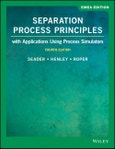Separation Process Principles with Applications Using Process Simulator, 4th EMEA Edition is the most comprehensive and up-to-date treatment of the major separation operations in the chemical industry. The 4th edition focuses on using process simulators to design separation processes and prepares readers for professional practice.
Table of Contents
About the Authors iiiPreface to the Fourth Edition v
General Nomenclature xiii
Dimensions and Units xvii
1. Separation Processes 1
1.0* Instructional Objectives 1
1.1* Industrial Chemical Processes 1
1.2* Basic Separation Techniques 3
1.3? Separations by Phase Creation 4
1.4? Separations by Phase Addition 6
1.5? Separations by Barrier 7
1.6? Separations by an External Field or Gradient 7
1.7* Brief Comparison of Common Separation Operations 8
1.8* Separation Processes, Product Purity, Component Recovery, and Separation Sequences 9
Summary, References, Study Questions, Exercises
2. Thermodynamics of Separation Operations 16
2.0* Instructional Objectives 16
2.1* Phase Equilibria 16
2.2* Ideal-Gas, Ideal-Liquid-Solution Model 20
2.3? Graphical Representation of Thermodynamic Properties 21
2.4? Nonideal Thermodynamic Property Models 23
2.5? P-v-T Equation-of-State (EOS) Models 23
2.6? Highly Nonideal Liquid Solutions 27
2.7? Gibbs Excess Free-Energy (gE) Models 29
2.8? Predictive Models 34
2.9? Electrolyte Solution Models 36
2.10? Polymer Solution Models 36
2.11* K-Value Methods in Process Simulators 36
2.12* Exergy and Second-Law Analysis 37
Nomenclature, Summary, References, Study Questions, Exercises
3. Mass Transfer and Diffusion 46
3.0* Instructional Objectives 46
3.1* Steady-State, Ordinary Molecular Diffusion 47
3.2* Diffusion Coefficients (Diffusivities) 51
3.3* Steady-State and Unsteady-State Mass Transfer Through Stationary Media 58
3.4* Mass Transfer in Laminar Flow 60
3.5* Mass Transfer in Turbulent Flow 68
3.6* Models for Mass Transfer in Fluids with a Fluid-Fluid Interface 73
3.7* Two-Film Theory and Overall Mass-Transfer Coefficients 76
Nomenclature, Summary, References, Study Questions, Exercises
4. Single Equilibrium Stages and Flash Calculations 87
4.0* Instructional Objectives 87
4.1* Gibbs’ Phase Rule and Degrees of Freedom 88
4.2* Binary Vapor-Liquid Systems at Equilibrium 89
4.3* Equilibrium Two-Phase Flash Calculations 93
4.4* Ternary Liquid-Liquid Systems at Equilibrium 97
4.5? Multicomponent Liquid-Liquid Systems 101
4.6* Liquid-Solid Systems 102
4.7* Gas-Liquid Systems 104
4.8* Gas-Solid Systems 105
4.9? Three-Phase Equilibrium Systems 107
Nomenclature, Summary, References, Study Questions, Exercises
5. Multistage Cascades and Hybrid Systems 118
5.0* Instructional Objectives 118
5.1* Cascade Configurations 118
5.2* Single-Section Liquid-Liquid Extraction Cascades 119
5.3* Two-Section Distillation Cascades 121
5.4? Membrane Cascades 123
5.5? Hybrid Systems 125
5.6* Degrees of Freedom and Specifications for Cascades 125
Nomenclature, Summary, References, Study Questions, Exercises
6. Absorption and Stripping 137
6.0* Instructional Objectives 137
6.1? Equipment for Vapor-Liquid Separations 138
6.2? General Design Considerations 143
6.3* Graphical Method for Trayed Towers 144
6.4* Kremser Group Method for Multicomponent Absorption and Stripping 148
6.5* Stage Efficiency and Column Height for Trayed Columns 154
6.6* Flooding, Column Diameter, and Tray Layout for Trayed Columns 161
6.7* Rate-Based Method for Packed Columns 164
6.8* Packed-Column Liquid Holdup, Diameter, Flooding, Pressure Drop, and Mass-Transfer Efficiency 169
6.9? Reactive (Chemical) Absorption 180
Nomenclature, Summary, References, Study Questions, Exercises
7. Distillation of Binary Mixtures 191
7.0* Instructional Objectives 191
7.1? Equipment and Design Considerations 193
7.2* McCabe-Thiele Graphical Method for Trayed Towers 193
7.3? Extensions of the McCabe-Thiele Method 203
7.4* Estimation of Tray Efficiency for Distillation 208
7.5* Column and Reflux-Drum Diameters 215
7.6* Rate-Based Method for Packed Distillation Columns 216
Nomenclature, Summary, References, Study Questions, Exercises
8. Liquid-Liquid Extraction with Ternary Systems 231
8.0* Instructional Objectives 231
8.1? Equipment for Solvent Extraction 233
8.2? General Design Considerations 239
8.3* Hunter-Nash Graphical Equilibrium-Stage Method 243
8.4? Theory and Scale-Up of Extractor Performance 252
Nomenclature, Summary, References, Study Questions, Exercises
9. Approximate Methods for Multicomponent Distillation 267
9.0* Instructional Objectives 267
9.1* Fenske-Underwood-Gilliland (FUG) Method 267
9.2* Using the Shortcut (FUG) Method with Process Simulators 279
Nomenclature, Summary, References, Study Questions, Exercises
10. Equilibrium-Based Methods for Multicomponent Absorption, Stripping, Distillation, and Extraction 284
10.0* Instructional Objectives 284
10.1* Simple Model for a Vapor-Liquid Equilibrium Stage 284
10.2? Evolution of Methods for Solving the Mesh Equations 286
10.3* Strategies for Applying Process-Simulator Methods 287
10.4* Main Mathematical Procedures 291
10.5* Bubble-Point (BP) and Sum-Rates (SR) Methods 294
10.6* Simultaneous-Correction Method 297
10.7* Inside-Out Method 304
10.8? Rigorous Methods for Liquid-Liquid Extraction 309
Nomenclature, Summary, References, Study Questions, Exercises
11. Enhanced Distillation and Supercritical Extraction 320
11.0* Instructional Objectives 320
11.1* Use of Triangular Graphs 321
11.2* Extractive Distillation 332
11.3? Salt Distillation 335
11.4? Pressure-Swing Distillation 337
11.5? Homogeneous Azeotropic Distillation 339
11.6* Heterogeneous Azeotropic Distillation 343
11.7? Reactive Distillation 352
11.8? Supercritical-Fluid Extraction 357
Nomenclature, Summary, References, Study Questions, Exercises
12. Rate-Based Models for Vapor-Liquid Separation Operations 368
12.0? Instructional Objectives 368
12.1? Rate-Based Model 370
12.2? Thermodynamic Properties and Transport-Rate Expressions 372
12.3? Methods for Estimating Transport Coefficients and Interfacial Area 375
12.4? Vapor and Liquid Flow Patterns 375
12.5? Method of Calculation 376
Nomenclature, Summary, References, Study Questions, Exercises
13. Batch Distillation 385
13.0* Instructional Objectives 385
13.1* Differential Distillation 385
13.2* Binary Batch Rectification 388
13.3? Batch Stripping and Complex Batch Distillation 390
13.4? Effect of Liquid Holdup 391
13.5* Stage-by-Stage Methods for Batch Rectification 391
13.6* Intermediate-Cut Strategy 400
13.7? Optimal Control by Variation of Reflux Ratio 401
Nomenclature, Summary, References, Study Questions, Exercises *Suitable for an UG course ?Optional ?Advanced
14. Membrane Separations 408
14.0* Instructional Objectives 408
14.1? Membrane Materials 410
14.2? Membrane Modules 414
14.3* Mass Transfer in Membranes 416
14.4* Dialysis 430
14.5? Electrodialysis 432
14.6* Reverse Osmosis 434
14.7* Gas Permeation 438
14.8? Pervaporation 441
Nomenclature, Summary, References, Study Questions, Exercises
15. Adsorption, Ion Exchange, and Chromatography 451
15.0* Instructional Objectives 451
15.1* Sorbents 453
15.2* Equilibrium Considerations 461
15.3* Kinetic and Transport Rate Considerations 470
15.4? Equipment for Sorption Operations 475
15.5* Slurry and Fixed-Bed Adsorption Systems 479
15.6* Continuous, Countercurrent Adsorption Systems 494
15.7? Ion-Exchange Cycle 502
15.8* Chromatographic Separations 503
Nomenclature, Summary, References, Study Questions, Exercises
Answers to Selected Exercises 519
Index 521








